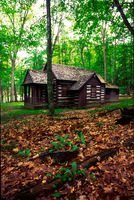 | Back to e-WV
| Back to e-WV
 The West Virginia Encyclopedia
The West Virginia Encyclopedia
 | Back to e-WV
| Back to e-WV
 The West Virginia Encyclopedia
The West Virginia Encyclopedia

The largest of West Virginia’s state parks, at 10,100 acres, Watoga is also among the oldest, dating back to the first land acquisitions by the West Virginia Game and Fish Commission in the 1920s. The park is located in southern Pocahontas County on the Greenbrier River. It was named for Watoga, a nearby town.
An initial 4,546 acres of former lumber company land was purchased from Watoga Land Association in January 1925 to create Watoga State Forest. The state purchased an additional 5,107 acres in August 1934 from the Maryland Lumber Company.
In 1926, a fire tower was erected. Two Civilian Conservation Corps camps were established, Camp Watoga in 1933 at the park’s present maintenance area and Camp Seebert at the mouth of Island Lick Run in 1934. Also in 1934 Watoga was changed from a state forest to a state park. A third CCC camp, Camp Will Rogers, was opened in 1935. By the time the camps were closed (Seebert and Will Rogers in 1937 and Watoga in 1942), the CCC had constructed 22 cabins, a superintendent’s residence, stable, restaurant-administration building, an 11-acre lake, horse and foot trails, 14 miles of roads, and a swimming pool. Deer, turkeys, raccoon, ducks, and pheasants raised at Watoga had been stocked in a seven county area. An area for an arboretum was set aside in 1938 as a memorial to Fred E. Brooks (1868–1933), a noted naturalist.
Watoga State Park was opened to the public on July 1, 1937. Later improvements include eight additional cabins, a bathhouse, the first state park campground in West Virginia, a second campground, a recreation building, paved roads, water and sewer improvements, and upgrading of the original cabins.
The Civilian Conservation Corps legacy at Watoga and other state facilities is remembered in an annual CCC reunion at Watoga State Park, a museum, and a statue of a CCC enrollee.
On October 18, 2021, the International Dark Sky Association named Watoga, along with Droop Mountain Battlefield State Park and Calvin W. Price State Forest, as West Virginia’s first site to be designated a Dark Sky Park. The expansive night skies and low light pollution are a boon to astronomers and anyone seeking a clear view of the Milky Way.
Written by William P. McNeel
West Virginia Celebrates Three New Dark Sky Parks. International Dark-Sky Association, October 18, 2021.